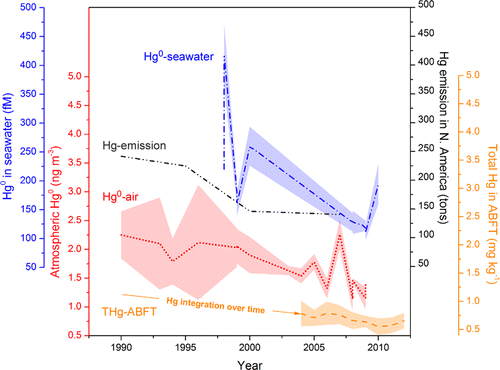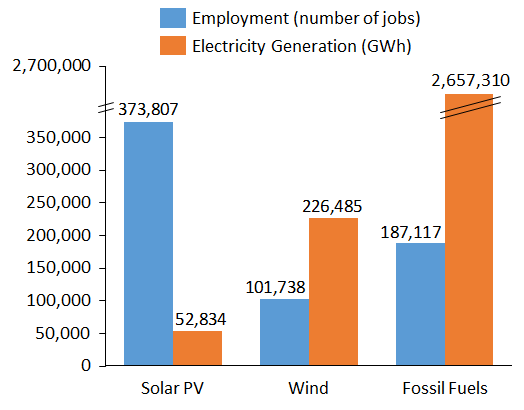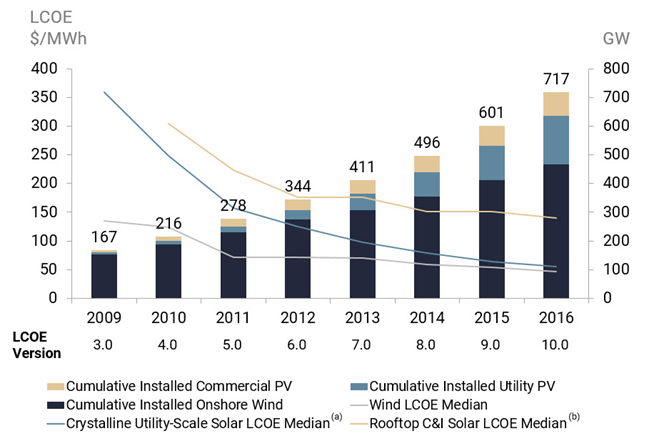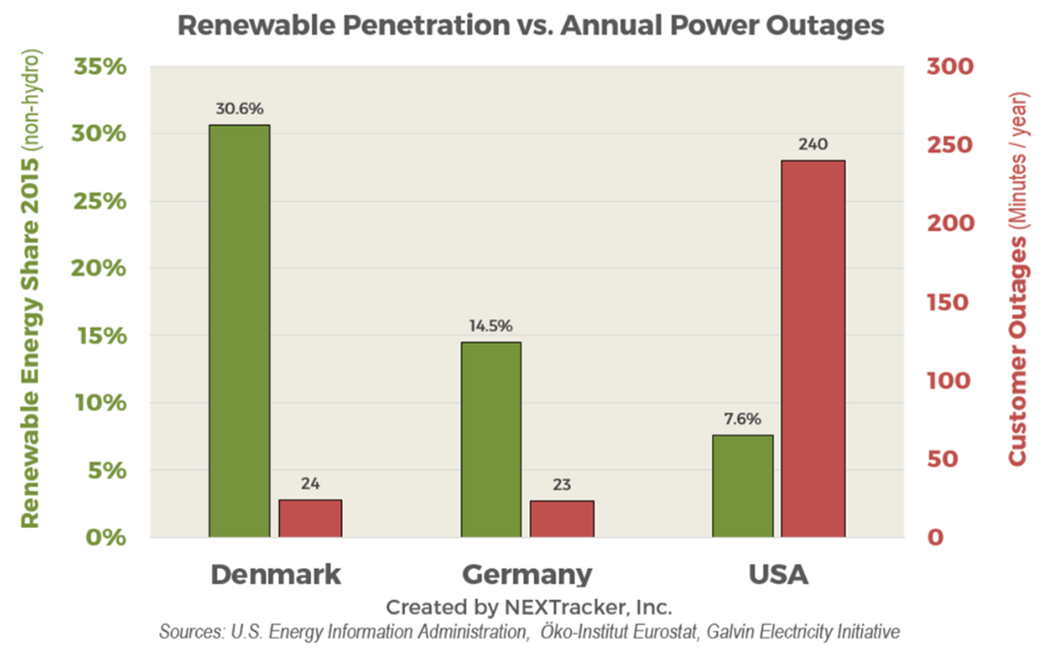Regardless of the scientific evidence for human caused climate change or global warming, the terms have deafened the ears of many. Our overly narrow political, economic, and social focus on their overly global concepts have made people skeptical, and rightly so. Going forward we will need to change that in order to solve the most pressing problems of our time.
If we really want to move the needle on sustainability, we need to paint crystal clear messages that are grounded in nearby reality, and shift our focus to the tangible problems of fossil fuels and the visible boons of renewable energy technologies.
Renewable energy matters in real ways beyond just trying to improve various line graphs and bar charts. We need to give them just as much or even more attention.
1. Less Toxicity
The first reason we need to quickly move to a renewable energy economy is to detoxify our bodies and environment.
Carcinogenic compounds are released everyday throughout the value chain of fossil fuels and in massive quantities. Whether during extraction, processing, or combustion, these toxic compounds are continuously emitted into our nearby air, soil, rivers, aquifers, oceans and eventually our bodies. They have been wreaking havoc on our health over long-periods of time.
Some of the most notorious compounds include:
- Heavy metals from coal mining (i.e. antimony, arsenic, beryllium, cadmium, chromium, cobalt, lead, manganese, mercury, nickel, selenium, and titanium)
- Fine particulate matter from coal combustion & diesel combustion (i.e. PM2.5 & PM10)
- Hydrocarbons from oil spills & coal, oil, gas combustion (i.e. polycyclic aromatic hydrocarbons)
- Radionuclides in oil & gas extraction (i.e. Radon)
But why does this matter in the here and now? Look no further than your tuna sandwich.

If you like tuna, the chart above has some good news and bad news for you.
The bad news is that every time you have a tuna sandwich, you are literally ingesting coal plant residue. The figure shows a strong correlation between mercury emissions (black line) and mercury concentration in Atlantic bluefish tuna (orange line) over time.
We can confirm the human-caused mercury concentration through simple sediment measurements spanning over hundreds of years. Looking at sand in the Mediterranean, we can see that there is currently about 7.5 times the amount of mercury in our ecosystems than before we began burning coal. That’s about as close to scientific causation as you can get.
But why does it matter? The compound is toxic enough to make the EPA recommend that pregnant women and children eat no more than a few cans a month. Not only that, studies have shown it can lead to all sorts of neurological diseases in grown adults (including Parkinsons and Alzheimers). The takeaway: the stuff is debilitating and you should definitely monitor your tuna consumption.
The good news from the chart is that between 2004 and 2012, mercury concentrations declined 19% in 1,292 tuna samples. This decline coincided almost perfectly with the 20% drop in coal use for US electric power over the same time period. Again a correlation but nonetheless a strong one.
Therefore it is very likely that as we phase out (or clean up) our coal resources and replace them with renewable energy technologies, we can only expect similar reductions in the mercury and other heavy metal concentrations of tuna and other important seafood.
This is huge considering that seafood feeds a portion of 4.5 billion people’s protein needs. And to keep it close to home: it means more delicious tuna sandwiches and healthy omega-3’s in your diet.
This is only one example of how we can reduce fossil fuel-derived toxic compounds in our bodies and the environment with renewable energy technologies.
The same can be done for the myriad of other compounds coming from our fossil-fired power plants. More breathable air, more drinkable water, more edible food, and less consequences for just living daily life are benefits of renewable energy technologies.
2. More Jobs
The second reason we need to move to a renewable energy economy is because it puts people to work. And I mean lots of people. Whether blue-collar, white-collar, or green-color, the solar and wind industries are putting more people to work per megawatt hour (MWh) of energy than the fossil fuel industry. Just take a look at the chart below.

The chart comes from the Department of Energy’s job data (in blue) and the Energy Information Administration’s electricity data (in orange) for the year 2016. What it shows is telling.
- First, the U.S. solar industry currently employs more people than the US fossil fuel industry for electricity generation.
- Secondly, there are 7 jobs per GWh of solar energy and about 0.5 jobs per GWh of wind energy, whereas there is only 0.1 jobs per GWh of fossil fuel energy used for electricity generation.
This is factoring in the recent boom in natural gas supplies and its abundant use in U.S. electricity generation. Not only that, even if you removed the construction & installation solar jobs (37% of the total), you would still have about 4.5 jobs per GWh of solar energy, or 45 times the amount of jobs per unit of energy than the fossil fuel sector employs for purposes of generating electricity.
Finally, these numbers don’t include the 47,634 jobs in battery energy storage, 19,745 jobs in smart grid transmission & distribution, and 14,890 jobs in microgrids that also make up the renewable energy economy. Clearly the renewable energy economy is putting people to work.
The numbers paint a clear picture of the job boon of renewable energy technologies… but why does it matter in the here and now?
Look no further than struggling cities like Richmond, CA where solar employment has made a real difference in communities. Organizations like Richmond Solar have been seen first-hand helping low-income families get off the ground with new solar jobs. They have helped hard-pressed families take part in the 1 of 50 new jobs in the U.S. that is coming from the solar industry — a staggering growth rate 17 times faster than the overall economy.
Based off employees hired into the solar industry in 2016, 35.5% of them had no prior experience in solar and only 32% of them had a bachelor’s degree or higher. Those transitioning from low-wage jobs made the move to a higher paying solar job within only one year’s time. That’s some real impact.
Plus, according to the Bureau of Labor Statistics (BLS), the 2016 average annual salary for a worker in the solar industry across all occupations was $90,250. Compare that to $77,990 paid to the average worker in the fossil fuel electric generation industry in the same year.
Workers in solar have healthier workplaces and aren’t exposed to the toxic compounds released in coal mines or gas plants that lead to lung cancer and other diseases. And they aren’t dealing with large deadly equipment on a regular basis either — equipment that between 1874 and 2014 caused 26,653 fatalities in fossil fuel energy systems (not including later deaths from cancer).
This is a step change in pay and safety from the past. Renewable energy jobs are better paying and safer jobs.
The renewable energy economy is real and it is putting people to work. It is giving people a good living, a safer living, and a living with a greater sense of purpose. What could be more worthwhile for our neighbors and the economy? Renewable energy technologies are having a marked impact.
3. Cheaper resources
The third reason we need to transition into a renewable energy economy is to bring down the costs of energy, food, and water — the basics that eat up almost a quarter or more of low to middle-income family budgets.
Little known to many is the fact that these three life supporting resources are highly interconnected. When technological and market advancements bring down the costs of one, so does it bring down the costs of the other two. This means that as renewable energy technologies successfully bring down the price of energy for homes, businesses, and utilities, so can it do the same for food and water.
Looking at the energy piece, we already see cost disparities for homes and businesses considering renewable energy technologies vs fossil fuel based electricity sources. The unsubsidized levelized cost of energy of U.S. solar and wind systems have dropped dramatically since the recession (LCOE is a metric that measures total system lifetime cost against total expected lifetime energy output).
The chart below from Lazard currently pins U.S. solar and wind LCOE at $55/MWh and $50/MWh respectively for utility-scale plants (gray & blue lines). For commercial and industrial solar plants it is at $150/MWh (beige line). Compared to the average LCOE of utility-scale gas and coal at $63/MWh and $101/MWh respectively, the disparity for large plants is clear.

While these numbers are averages and the dominant fuel source will still be geography and regulation dependent, on the whole, the picture is telling.
Unsubsidized gas and coal LCOE (which are subsidized to the tune of $20B/yr in the U.S.) are not dropping anywhere near the pace of wind and solar LCOE (66% and 85% respectively for utility-scale plants over the past 7 years). This is all while not considering the “hidden” costs imposed by fossil fuels, such as the healthcare costs rising from its toxic compounds (estimated to cost $300-$800 billion annually).
But big numbers aside, what does this mean practically speaking? It’s helping small-business farmers thrive and preserve more sustainable forms of agriculture amidst rising pressures from industrial agriculture, and providing cheaper food. Here are a few examples.
Rivermaid Trading Company is a California fruit grower that produces 50% of the state’s pears and 8% of its cherries. They put up 1.47 megawatts of solar pv on their facility roofs and offset 60% of their summer energy use. Their expected annual savings are over $300,000 and $13 million over the life of the system.
Delvin Farms is a 120 acre middle Tennessee organic farm that grows all sorts of fruits and vegetables. They supplied 100% of their energy needs with 122 rooftop solar panels and cut their electric bill from $900/month to $500/month. The decision, while part philosophical, was driven by business fundamentals of cheaper costs and better brand marketing with solar panels.
Del Rey Avocado is a family-owned organic avocado producer in California. The 800-acre farm installed 10-acres of solar panels to help cover the costs of pumping and recycling treated water. The site was large enough to cover all their electricity needs and export some back to the grid.
These are only a few example where the economics of renewable energy technologies are penciling out for farmers in sunny geographies. Cheaper energy means cheaper water means cheaper food, for everyone. As the costs of solar and wind continue to decline, this trend will only continue to help those who pay the most for the basics of life.
4. Greater Security
The fourth main reason we need to transition into a renewable energy economy is to improve the security of the grid and nation. The conventional, one-way, and centralized model of sending electrons from a fossil-fired generator to a home isn’t entirely reliable… not considering where the fuel comes from in the first place.
The mess of shipping cargoes, rail freights, substations, transmission lines, more substations, and distribution lines between the supply and demand of electricity make the grid a hefty and volatile system. It isn’t to say this same infrastructure will be gone in a renewable energy world — it is just going to be used in a much smarter way.
Energy security can be defined in many ways. The International Energy Agency defines it in terms of time horizon: in the long-term it means stable supply chains that promote economic development and environmental needs, and in the short-term the ability of the grid to quickly react to sudden changes in supply-demand. Under this broad umbrella we can find a plethora of energy security benefits from renewable energy technologies.
From a shorter-term power uptime standpoint, an interesting correlation from market leading NEXTracker gives a glimpse of how countries with high levels of renewable energy penetration (Denmark & Germany) have fared against a country without much renewable energy (the U.S.) in terms of minutes/year of power outages.

The chart shows a clear contrast between the European renewable energy leaders and America. Denmark and Germany have more stable power grids than the U.S. and higher levels of renewable penetration. Whether the outages tallied here were planned or not, something seems to be fundamentally different between the nations’ energy systems.
The meat behind the correlation lies in the fact that while renewable energy resources are distributed, abundant and readily attainable, fossil fuel resources are not. Furthermore, when managed by smart grid software and batteries, renewable energy resources become far more secure energy sources for businesses, cities and nations in the short-term and long-term.
Here are examples of the energy security that renewable energy resources and technologies provide:
- From an individual home-level standpoint, renewable energy technologies hedge against the risk of continuously rising retail electricity prices (averaging about 2.2% annual growth across the country since 1990).
- From a building-level standpoint, renewable energy technologies help less critical facilities get caught off guard during important operations (like doctors performing surgeries, 911 operators taking calls, or data centers cranking calculations for other critical facilities).
- From a system-level standpoint, renewable energy technologies mitigate the economic damage of super storms on tax- and rate-payer infrastructure (like Hurricane Sandy with approximate cost ~$30-$50 billion).
- From a geopolitical-level standpoint, renewable energy technologies reduce and eliminate the reliance on foreign energy resources (like gas from Russia, oil from Saudi Arabia, or coal from China).
- From a cyber-level standpoint, renewable energy technologies can limit the damage hackers can do on any given plant (whether they are makeshift or actual infrastructure).
No matter what angle you approach energy security, renewable energy resources and technologies always come out on top because of their local and decentralized nature. Both in the short-term and long-term they provide more physical, economic, and geopolitical security to all stakeholders of the grid. That alone is a sufficient reason to invest in renewable energy.
In sum, it is no coincidence that these four points are big reasons for why renewable energy matters at a very tangible level. Each of these points are interrelated and support the continued growth of the rewewable energy economy as a whole.
There is no need to guilt trip about drowning polar bears or disappearing coral reefs. Deep decarbonization and radical reorganization of the grid is entirely possible. That’s why we need to focus on why renewable energy matters and champion its importance every day.








